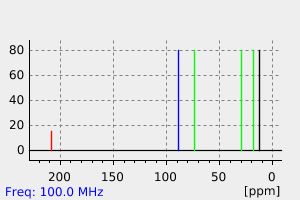1,2-己二烯 | 592-44-9
中文名称
1,2-己二烯
中文别名
——
英文名称
1,2-hexadiene
英文别名
Hexadien-(1,2);Hexa-1,2-dien;1,2-Hexadien;1,2-hexandiene
CAS
592-44-9
化学式
C6H10
mdl
——
分子量
82.1454
InChiKey
XIAJQOBRHVKGSP-UHFFFAOYSA-N
BEILSTEIN
——
EINECS
——
-
物化性质
-
计算性质
-
ADMET
-
安全信息
-
SDS
-
制备方法与用途
-
上下游信息
-
文献信息
-
表征谱图
-
同类化合物
-
相关功能分类
-
相关结构分类
物化性质
-
熔点:-94.9°C (estimate)
-
沸点:74.85°C
-
密度:0.7102
计算性质
-
辛醇/水分配系数(LogP):2
-
重原子数:6
-
可旋转键数:2
-
环数:0.0
-
sp3杂化的碳原子比例:0.5
-
拓扑面积:0
-
氢给体数:0
-
氢受体数:0
安全信息
-
海关编码:2901299090
SDS
上下游信息
反应信息
-
作为反应物:参考文献:名称:Hennion; Sheehan, Journal of the American Chemical Society, 1949, vol. 71, p. 1965摘要:DOI:
-
作为产物:描述:参考文献:名称:Bouis, Comptes Rendus Hebdomadaires des Seances de l'Academie des Sciences, 1926, vol. 183, p. 134摘要:DOI:
文献信息
-
Etude expérimentale et théorique de l'addition de l'acide hypochloreux sur les hydrocarbures alléniques作者:J.-P. Bianchini、M. CocordanoDOI:10.1016/s0040-4020(01)92917-5日期:——The addition of hypochlorous acid to allenic hydrocarbons leads, in all cases, to the fixation of the Cl atom on the central carbon and to the fixation of the OH group on the more substituted carbon. The (α-chloroketones which might be produced by the inverse fixation are not obtained. The utilisation of Hückel's method explains these results theoretically and satisfactorily.
-
Cu-Catalyzed C–H Allylation of Benzimidazoles with Allenes作者:Yaxi Dong、Bernhard BreitDOI:10.1021/acs.orglett.1c02346日期:2021.9.3CuH-catalyzed intramolecular cyclization and intermolecular allylation of benzimidazoles with allenes have been described. The reaction proceeded smoothly with the catalytic system of Cu(OAc)2/Xantphos and catalytic amount of (MeO)2MeSiH. This protocol features mild reaction conditions and a good tolerance of substrates bearing electron-withdrawing, electron-donating, or electron-neutral groups. A
-
Polylithiumorganic compounds作者:Adalbert Maercker、Andrea Tatai、Burkhard Grebe、Ulrich GirreserDOI:10.1016/s0022-328x(01)01195-0日期:2002.1observed. The metalation products 5–7 show follow-up reactions like 1,3-H shift to the corresponding 1-lithio-1-alkynes 8 and subsequent metalation to the dilithioalkynes 9. Additionally, lithium hydride elimination and ring-chain rearrangement (for 5c) are observed. 1,2-Hexadiene (3b) can be brought to reaction with lithium metal in the apolar solvent pentane, here the follow-up reactions are much slower研究了丙烯(3a)与烷基取代的丙烯1,2-己二烯(3b),环丙烯(3c)和亚乙烯基环丙烷(3d)与锂金属的反应,以获得2,3-二硫代烯烃4a - d。这些二硫代烯烃4a - d在极性溶剂(如THF)中具有很高的反应性,并作为强碱,可以观察到起始丙二烯3a - d或该溶剂的金属化或足够酸性的中间体(如8 a - d)。金属制品5 – 7显示后续反应,如1,3-H转移到相应的1-lithio-1-炔烃8和随后的金属化到dilithioalkynes 9。此外,观察到氢化锂消除和环链重排(对于5c)。1,2-己二烯(3b)可以在非极性溶剂戊烷中与锂金属反应,由于4b的不溶性,因此后续反应要慢得多。在所有情况下,通过用简单的亲电试剂淬灭,形成区域异构体和立体异构体产物的复杂混合物阻碍了对反应途径的阐明。
-
Allenes. Part XV. The addition of dihalocarbenes to allenes and conversion of 1,1-dihalo-2-methylenecyclopropanes to cumulenes作者:W. J. Ball、S. R. Landor、N. PunjaDOI:10.1039/j39670000194日期:——The addition of dichloro- and dibromo-carbenes to the more substituted double bond of five different allenes gave 1,1-dichloro- and 1,1-dibromo-2-methylenecyclopropanes. Some of these have been converted by means of n-butyl lithium to cumulenes.
-
A two-step of synthesis of allenes from olefins作者:W. von E. Doering、P.M. LaFlammeDOI:10.1016/0040-4020(58)88025-4日期:——In a two-step sequence, of which the first step involves addition of dibromocarbene to an olefin and the second involves reaction of the resulting substituted 1,1-dibromocyclopropane with magnesium or sodium, allenes are obtained. The overall structural change involves the insertion of a single carbon atom between the two of the original double bond and therefore represents a novel way of increasing
表征谱图
-
氢谱1HNMR
-
质谱MS
-
碳谱13CNMR
-
红外IR
-
拉曼Raman
-
峰位数据
-
峰位匹配
-
表征信息
同类化合物
辛-3,4-二烯
癸-3,4-二烯
癸-2,3-二烯
癸-1,2-二烯
炔丙基自由基
庚-1,2-二烯
己-1,2,4,5-四烯
壬-4,5-二烯
十二碳-2,3-二烯
十二碳-1,2-二烯
十三碳-4,5-二烯
十一碳-1,3,4-三烯
十一碳-1,2-二烯
丙二烯-d4
丙二烯
C=C=C-H自由基
7-甲基辛-3,4-二烯
7,7-二甲基辛-3,4-二烯
6,6-二甲基-庚-2,3-二烯
5-甲基-1,2-己二烯
5,6-十一碳二烯
4-甲基戊-1,2-二烯
4-甲基-1,2,5-己三烯
3,4-庚二烯
3,4-壬二烯
2-甲基-4,5-壬二烯
2,3-辛二烯
2,3-戊二烯
2,3-壬二烯
2,2-二甲基-1,3,5-己三烯
2,2,6,6-四甲基庚-3,4-二烯
1-叔丁基丙二烯
1-二乙基膦基-戊二烯-(2,3)
1,2-辛二烯
1,2-戊二烯
1,2-己二烯
1,2-壬二烯
1,2-十三碳二烯
1,2-丁二烯
1,2,5-己三烯
1,2,4-戊三烯
1,2,3-丁三烯
1-Diaethylphosphino-hexadien-(2.3)
1-pentyl-3-pentylallene
tert-butyl-3-deuterioallene
penta-2,3-diene
2-methylundeca-3,4-diene
2-Methyl-nonatrien-(5,6,8)
(4,4-dimethylpenta-1,2-dien-1-yl)silver
2,2-dimethyl-3,4-heptadiene







